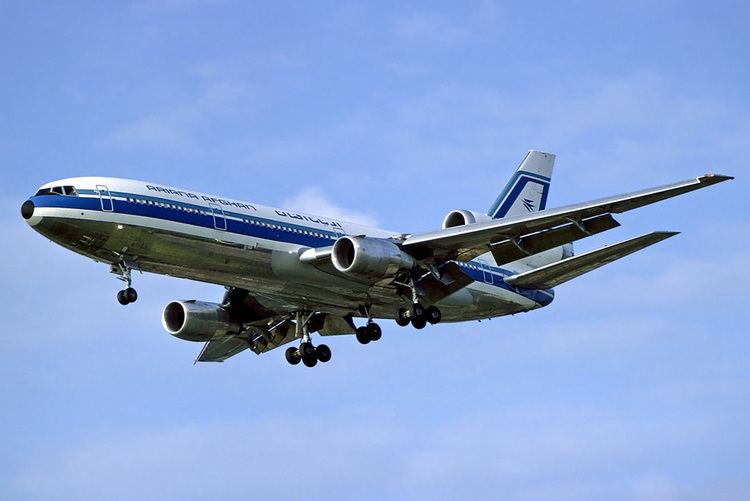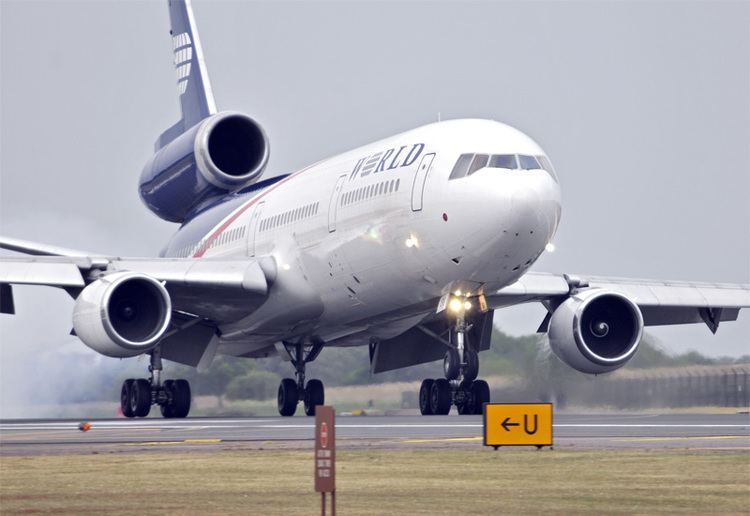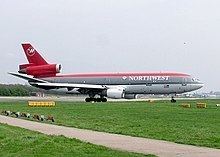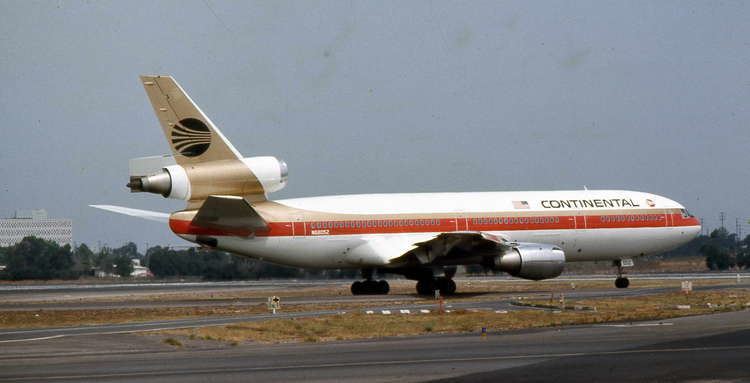Top speed 982 km/h Engine type Turbofan | Cruise speed 908 km/h | |
 | ||
The McDonnell Douglas DC-10 is a three-engine wide-body jet airliner manufactured by McDonnell Douglas. The DC-10 has range for medium- to long-haul flights, capable of carrying a maximum of 380 passengers. It features two turbofan engines mounted on underwing pylons and a third engine at the base of the vertical stabilizer. The model was a successor to McDonnell Douglas's DC-8 for long-range operations, and competed in the same markets as the Lockheed L-1011 TriStar, which has a similar layout. In its early years the DC-10 had a poor safety record; however, this has greatly improved over time.
Contents
- Development
- Design
- Original variants
- Longer range variants
- Tanker versions
- MD 10 upgrade
- Operators
- Incidents and accidents
- Cargo door problem
- American Airlines Flight 96
- Turkish Airlines Flight 981
- American Airlines Flight 191
- United Airlines Flight 232
- Other notable accidents and incidents
- Aircraft on display
- Specifications
- References

Production of the DC-10 ended in 1989 with 386 delivered to airlines and 60 to the U.S. Air Force as air-to-air refueling tankers, designated KC-10 Extender. The largest operator of the DC-10 is U.S. cargo airline FedEx Express. The DC-10 was succeeded by the related McDonnell Douglas MD-11. Boeing, which merged with McDonnell Douglas in 1997, conducted an upgrade program that equipped many in-service DC-10s with a glass cockpit that eliminated the flight engineer position; the upgraded aircraft were re-designated as MD-10s. The DC-10's last commercial passenger flight took place in February 2014, although freighter versions continue to operate. Despite the airliner's popularity, only a few DC-10s are on display, while other retired aircraft are in storage. DC-10s are also used for specialist services, such as the Orbis International Flying Eye Hospital, which has a compartment for performing eye surgery.

Development

Following an unsuccessful proposal for the U.S. Air Force's CX-HLS (Heavy Logistics System) in 1965, Douglas Aircraft began design studies based on its CX-HLS design. In 1966, American Airlines offered a specification to manufacturers for a widebody aircraft smaller than the Boeing 747 but capable of flying similar long-range routes from airports with shorter runways. The DC-10 became McDonnell Douglas's first commercial airliner after the merger between McDonnell Aircraft Corporation and Douglas Aircraft Company in 1967. An early DC-10 design proposal was for a four-engine double-deck wide-body jet airliner with a maximum seating capacity of 550 passengers similar in length of a DC-8. The proposal was shelved in favor of a trijet single-deck wide-body airliner with a maximum seating capacity of 399 passengers, and similar in length to the DC-8 Super 60.
The DC-10 was first ordered by launch customers American Airlines with 25 orders, and United Airlines with 30 orders and 30 options in 1968. The first DC-10, a series 10, made its maiden flight on August 29, 1970. Following a test program with 929 flights covering 1,551 hours, the DC-10 received its type certificate from the FAA on July 29, 1971. It entered commercial service with American Airlines on August 5, 1971 on a round trip flight between Los Angeles and Chicago. United Airlines began DC-10 service on August 16, 1971. American's DC-10s had 206 seats and United's had 222; both had six-across seating in first-class and eight-across (four pairs) in coach. The DC-10's similarity to the Lockheed L-1011 in design, passenger capacity, and launch date resulted in a sales competition that affected profitability of the aircraft.

The first DC-10 version was the "domestic" series 10 with a range of 3,800 miles (3,300 nmi, 6,110 km) with a typical passenger load and a range of 2,710 miles (2,350 nmi, 4,360 km) with maximum payload. The series 15 had a typical load range of 4,350 miles (3,780 nmi, 7,000 km). The series 20 was powered by Pratt & Whitney JT9D turbofan engines, whereas the series 10 and 30 engines were General Electric CF6. Before delivery of its aircraft, Northwest's president asked that the "series 20" aircraft be redesignated "series 40" because the aircraft was much improved over the original design. The FAA issued the series 40 certificate on October 27, 1972.
The series 30 and 40 were the longer-range "international" versions. The main visible difference between the models is that the series 10 has three sets of landing gear (one front and two main) while the series 30 and 40 have an additional centerline main gear. The center main two-wheel landing gear (which extends from the center of the fuselage) was added to distribute the extra weight and for additional braking. The series 30 had a typical load range of 6,220 mi (10,010 km) and a maximum payload range of 4,604 mi (7,410 km). The series 40 had a typical load range of 5,750 miles (9,265 km) and a maximum payload range of 4,030 miles (3,500 nmi, 6,490 km).
The DC-10 had two engine options and introduced longer-range variants a few years after entering service; these allowed it to distinguish itself from its main competitor, the L-1011. The 446th and final DC-10 rolled off the Long Beach, California Products Division production line in December 1988 and was delivered to Nigeria Airways in July 1989. The production run exceeded the 1971 estimate of 438 deliveries needed to break even on the project. As the final DC-10s were delivered McDonnell Douglas had started production of its successor, the MD-11.
Design
The DC-10 is a low-wing cantilever monoplane, powered by three turbofan engines. Two engines are mounted on pylons that attach to the bottom of the wings, while the third engine is encased in a protective banjo-shaped structure that is mounted on the top of the rear fuselage. The vertical stabilizer with its two-segment rudder, is mounted on top of the tail engine banjo. The horizontal stabilizer with its four-segment elevator is attached to the sides of the rear fuselage in the conventional manner. The airliner has a retractable tricycle landing gear. To enable higher gross weights, the later -30 and -40 series have an additional two-wheel main landing gear, which retracts into the center of the fuselage.
It was designed for medium to long-range flights that can accommodate 250 to 380 passengers, and is operated by a cockpit flight crew of three. The fuselage has underfloor storage for cargo and baggage.
Original variants
Longer-range variants
Tanker versions
The KC-10 Extender is a military version of the DC-10-30CF for aerial refueling. The aircraft was ordered by the U.S. Air Force and delivered from 1981 to 1988. A total of 60 were built.
The KDC-10 is an aerial refueling tanker for the Royal Netherlands Air Force. These were converted from civil airliners (DC-10-30CF) to a similar standard as the KC-10. Also, commercial refueling companies Omega Aerial Refueling Services and Global Airtanker Service operate two KDC-10 tankers for lease. Four have been built.
The DC-10 Air Tanker is a DC-10-based firefighting tanker aircraft, using modified water tanks from Erickson Air-Crane.
MD-10 upgrade
The MD-10 is retrofit cockpit upgrade to the DC-10 and a re-designation to MD-10. The upgrade included an Advanced Common Flightdeck (ACF) used on the MD-11 and was launched in 1996. The new cockpit eliminated the need for the flight engineer position and allowed common type rating with the MD-11. This allows companies such as FedEx Express, which operate both the MD-10 and MD-11, to have a common pilot pool for both aircraft. The MD-10 conversion now falls under the Boeing Converted Freighter program where Boeing's international affiliate companies perform the conversions.
Operators
In July 2015, there were 56 DC-10s and MD-10s in airline service with operators FedEx Express (50), Kelowna Flightcraft Air Charter (2), and others with fewer aircraft. The aging models are now largely used as dedicated freight aircraft. "The DC-10 is going to be remembered as a better cargo plane than passenger plane," said Richard Aboulafia, an analyst with the Teal Group.
On January 8, 2007, Northwest Airlines retired its last remaining DC-10 from scheduled passenger service, thus ending the aircraft's operations with major airlines. Regarding the retirement of Northwest's DC-10 fleet, Wade Blaufuss, spokesman for the Northwest chapter of the Air Line Pilots Association said, "The DC-10 is a reliable airplane, fun to fly, roomy and quiet, kind of like flying an old Cadillac Fleetwood. We're sad to see an old friend go." Biman Bangladesh Airlines was the last commercial carrier to operate the DC-10 in passenger service. The airline flew the DC-10 on a regular passenger flight for the last time on February 20, 2014, from Dhaka, Bangladesh to Birmingham, UK. Local charter flights were flown in the UK until February 24, 2014.
Non-airline operators include the Royal Netherlands Air Force with three DC-10-30CF-based KDC-10 tanker aircraft, the USAF with its 59 KC-10s, and the 10 Tanker Air Carrier with its modified DC-10-10 used for fighting wildfires. Orbis International has used a DC-10 as a flying eye hospital. Surgery is performed on the ground and the operating room is located between the wings for maximum stability. In 2008, Orbis chose to replace its aging DC-10-10 with a DC-10-30 jointly donated by FedEx and United Airlines. The newer DC-10 was to be converted into MD-10 configuration, and begin flying as an eye hospital in 2010. One former American Airlines DC-10-10 is operated by the Missile Defense Agency as the Widebody Airborne Sensor Platform (WASP).
Incidents and accidents
As of September 2015, the DC-10 has been involved in 55 accidents and incidents, including 32 hull-loss accidents, with 1,261 occupant fatalities. Of these accidents and incidents, it has been involved in 9 hijackings resulting in 1 death and a bombing resulting in 170 occupant fatalities. Despite its troubled beginnings in the 1970s, which gave it an unfavorable reputation, the DC-10 has proved to be a reliable aircraft with an overall low accident rate as of 1998. The DC-10's initially poor safety record has continuously improved as design flaws were rectified and fleet hours increased. The DC-10's lifetime safety record is comparable to similar second-generation passenger jets as of 2008.
Cargo door problem
The DC-10 was designed with cargo doors that opened outward instead of conventional inward-opening "plug-type" doors. Using outward-opening doors allowed the DC-10's cargo area to be completely filled since the door was not occupying usable interior space when open. To secure the door against the outward force from the pressurization of the fuselage at high altitudes, outward-opening doors must use heavy locking mechanisms. In the event of a door lock malfunction, there is great potential for explosive decompression.
American Airlines Flight 96
A problem with the outward-opening cargo door first became publicly known on June 12, 1972, when American Airlines Flight 96 lost its aft cargo door shortly after takeoff from Detroit Metro Airport, in flight above Windsor, Ontario. Before Flight 96 took off, an airport employee had forced the door shut, which, due to the cargo door's design, gave an outward appearance of being securely locked despite the internal locking mechanism not being fully engaged. Subsequently, when the aircraft reached approximately 11,750 feet (3,580 m) in altitude, the rear cargo door blew out, causing an explosive decompression that partially collapsed the cabin floor above the door. This collapsed section of the floor cut or impeded many of the control cables to the empennage control systems necessary to fly the aircraft. The crew performed an emergency landing by using the ailerons, right elevator, some limited rudder trim, and asymmetrical thrust of the wing engines. The passengers evacuated safely.
During the investigation of the near-crash of Flight 96, U.S. National Transportation Safety Board (NTSB) investigators found that the DC-10's cargo door design was dangerously flawed. The door relied on a set of heavy steel hooks to secure it against the door frame. When the hooks were fully engaged, an outside lever on the cargo door could be depressed to drive a set of locking pins through the hooks to hold them in place. The NTSB investigation found that it was possible to close the outside lever without the hooks being fully engaged, and there would be no outward signs that the locking mechanism was not engaged; the cargo door indicator in the cockpit would still register the door as being secured without hooks and locking pins being in the closed position. This combination of factors caused Flight 96 to take off without its aft cargo door being fully locked. When the door blew out at altitude, the sudden decompression created a large pressure differential between the cabin above and the cargo bay below, causing the cabin floor to collapse. The collapse of the cabin floor severely damaged some of the vital flight control wires and hydraulic lines routed through the floor beams, which left the pilots with very limited control of the aircraft.
Following the Windsor accident investigation, the NTSB made several recommendations, including repairing the faulty cargo door design to make it impossible for baggage handlers to close the cargo door lever without the locking pins being fully engaged. It was also recommended that vents be installed in the cabin floor so that, in case of an explosive decompression, the pressure difference between the cabin and cargo bay could quickly be equalized without collapsing the cabin floor and damaging critical control systems. Although many carriers voluntarily modified the cargo doors, no airworthiness directive was issued to require reworking of the locking system, due to a gentlemen's agreement between the heads of the FAA, John H. Shaffer, and McDonnell Douglas, Jackson McGowen. McDonnell Douglas did make modifications to the cargo door, but the basic design remained unchanged and problems persisted.
Turkish Airlines Flight 981
On March 3, 1974, an almost identical cargo door blow-out caused Turkish Airlines Flight 981 to crash into a forest near the town of Ermenonville, France shortly after leaving Paris. All 346 people were killed; it was one of the deadliest air crashes of all time. Circumstances of this crash were very similar to the previous accident. The cargo door had not been fully locked, though it appeared so to both cockpit crew and ground personnel. The Turkish aircraft had a different seating configuration that exacerbated the effects of decompression, which caused the aircraft's floor to collapse into the cargo bay. Control cables running through the floor beams were severed when the floor collapsed and rendered the aircraft uncontrollable. Crash investigators found that the DC-10's relief vents were not large enough to equalize the pressure between the passenger and cargo compartments during explosive decompression. Following this crash, a special subcommittee of the House of Representatives investigated the cargo door issue and the FAA's certification of the original design. An airworthiness directive was issued, and all DC-10s underwent mandatory door modifications. The DC-10 experienced no more major incidents related to its cargo door after FAA-approved changes were made.
American Airlines Flight 191
The DC-10 was involved in another deadly crash on May 25, 1979, when American Airlines flight 191, departing Chicago's O'Hare Airport, went out of control immediately after takeoff. As the airliner rotated during its takeoff roll, the number one (left wing) engine and pylon assembly separated from and swung upward over the top of the wing, severing critical hydraulic lines embedded in the wing's leading edge, as well as tearing away part of the wing structure. The loss of hydraulic pressure to the leading edge slat actuators caused the slats to retract due to aerodynamic forces, increasing the left wing's stall speed above the engine failure climb out speed being used by the pilots. With the left wing stalled and further destabilized by asymmetric thrust, the DC-10 rapidly rolled to the left, sharply descended and crashed, killing all 271 people on board, together with two individuals on the ground. The loss of flight 191 remains the deadliest plane crash in U.S. history.
The National Transportation Safety Board (NTSB) officials discovered that a maintenance procedure was the cause. American Airlines mechanics had removed the engine and its pylon as a unit, rather than removing the engine from the pylon then removing the pylon from the wing, as recommended by McDonnell Douglas. The faulty procedure was done using a forklift which resulted in inadvertent structural damage. It was subsequently discovered that this short-cut procedure, believed to save many man-hours on maintenance, was being used by three major airlines, although McDonnell Douglas had advised against it. In November 1979, the Federal Aviation Administration (FAA) fined American Airlines $500,000 for using this faulty maintenance procedure. Continental Airlines was similarly fined $100,000.
The Flight 191 crash highlighted a major deficiency in the DC-10 design: its lack of a locking mechanism to maintain the position of the leading-edge slats in the event of a hydraulic or pneumatic actuation failure. The DC-10's design depended on the principle of hydrostatic lock to keep the slats extended against aerodynamic forces, whereas other aircraft use a positive mechanical system, such as Acme screw actuation, to maintain slat position. It was determined that when the engine and pylon assembly pulled up and over the wing, it severed electrical wiring in the wing, thus rendering vital warning instruments in the cockpit inoperable. Following the Chicago crash, the FAA withdrew the DC-10's type certificate on June 6, 1979, which grounded U.S. DC-10s. It also banned all DC-10s from U.S. airspace. These measures were rescinded on July 13 after modifications were made to the slat actuation and position systems, along with stall warning and power supply changes.
United Airlines Flight 232
Another major DC-10 crash was the United Airlines Flight 232 crash at Sioux City, Iowa, on July 19, 1989. The number two (tail) engine suffered an uncontained fan disk failure in flight, which damaged all three hydraulic systems and rendered the hydraulic flight controls inoperable. The flight crew, led by Captain Al Haynes and assisted by a senior pilot flying as a passenger (Dennis E. "Denny" Fitch), performed an emergency landing by constantly adjusting the thrust of the remaining two engines. The crew managed to fly the aircraft onto the runway in a partially controlled manner, and 185 of the 296 people on board survived in spite of the destruction of the aircraft during the crash-landing.
The DC-10 included no cable backup for the hydraulic powered flight controls because it was considered nearly impossible for three hydraulic systems to fail during one flight, and the control surfaces are too large to be moved without hydraulic assistance. All three hydraulic systems were in close proximity, directly beneath the tail engine. The #2 engine explosion hurled fragments that ruptured all three lines, resulting in total loss of control to the elevators, ailerons, spoilers, horizontal stabilizer, rudder, flaps and slats.
Following the UAL 232 accident, hydraulic fuses were installed in the #3 hydraulic system in the area below the #2 engine on all DC-10 aircraft to ensure that sufficient control capability remained if all three hydraulic system lines should be damaged in the tail area. It is still possible to lose all three hydraulic systems elsewhere. This nearly occurred to a cargo airliner in 2002 during takeoff, when a main gear tire exploded in the wheel well. The damage in the left wing area caused total loss of pressure in the #1 and the #2 hydraulic systems. The #3 system was dented but not penetrated.
Other notable accidents and incidents
Other notable incidents and accidents are:
The Air France Concorde crash in 2000 was attributed to a metal fragment that fell from the thrust reverser of a Continental Airlines DC-10 that had taken off four minutes earlier. This fragment was traced to third-party replacement parts not approved by the Federal Aviation Administration.
Numerous DC-10s have also been damaged or written off by overrunning the runway or environmental hazards.
